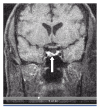A rare corticotroph-secreting tumor with coexisting prolactin and growth hormone staining cells
- PMID: 23320206
- PMCID: PMC3534206
- DOI: 10.1155/2012/529730
A rare corticotroph-secreting tumor with coexisting prolactin and growth hormone staining cells
Abstract
Pituitary adenomas can express and secrete different hormones. Expression of pituitary hormones in nonneoplastic pituitary cells is regulated by different transcription factors. Some pituitary adenomas show plurihormonal expression. The most commonly reported plurihormonal adenomas are composed of somatotrophs, lactotrophs, thyrotrophs and gonadotrophs. Pituitary adenomas composed of both corticotroph and somatolactotroph secreting cells are not common because transcription factors regulating the expression of these hormones are different. We report a rare case of pituitary adenoma with concomitant corticotroph, prolactin, and growth hormone staining cells, review literature on similar cases, and discuss possible biological mechanisms underlying these plurihormonal tumors.
Figures


Similar articles
-
Plurihormonal pituitary macroadenoma: a case report.J Med Case Rep. 2021 Jul 29;15(1):407. doi: 10.1186/s13256-021-02948-6. J Med Case Rep. 2021. PMID: 34321093 Free PMC article.
-
Low expression of the cell cycle inhibitor p27Kip1 in normal corticotroph cells, corticotroph tumors, and malignant pituitary tumors.J Clin Endocrinol Metab. 1999 Oct;84(10):3823-30. doi: 10.1210/jcem.84.10.6066. J Clin Endocrinol Metab. 1999. PMID: 10523037
-
Coexpression of galanin and adrenocorticotropic hormone in human pituitary and pituitary adenomas.Am J Pathol. 1991 Apr;138(4):897-909. Am J Pathol. 1991. PMID: 1707237 Free PMC article.
-
Refractory Pit1 plurihormonal tumours and thyrotroph adenomas.Pituitary. 2023 Apr;26(2):182-186. doi: 10.1007/s11102-023-01312-9. Epub 2023 Apr 29. Pituitary. 2023. PMID: 37117845 Free PMC article. Review.
-
Detection of programmed death ligand 1 protein and CD8+ lymphocyte infiltration in plurihormonal pituitary adenomas: A case report and review of the literatures.Medicine (Baltimore). 2017 Dec;96(49):e9056. doi: 10.1097/MD.0000000000009056. Medicine (Baltimore). 2017. PMID: 29245312 Free PMC article. Review.
Cited by
-
Plurihormonal pituitary macroadenoma: a case report.J Med Case Rep. 2021 Jul 29;15(1):407. doi: 10.1186/s13256-021-02948-6. J Med Case Rep. 2021. PMID: 34321093 Free PMC article.
-
Double pituitary adenomas are most commonly associated with GH- and ACTH-secreting tumors: systematic review of the literature.Pituitary. 2017 Dec;20(6):702-708. doi: 10.1007/s11102-017-0826-6. Pituitary. 2017. PMID: 28766078
References
-
- Arita K, Uozumi T, Kuwabara S, et al. A case of pituitary adenoma producing both growth hormone (GH) and adrenocorticotropic hormone (ACTH) Endocrinologia Japonica. 1991;38(3):271–278. - PubMed
-
- Blevins LS, Jr., Hall GS, Madoff DH, Laws ER, Wand GS. Case report: acromegaly and Cushing’s disease in a patient with synchronous pituitary adenomas. American Journal of the Medical Sciences. 1992;304(5):294–297. - PubMed
-
- Apel RL, Wilson RJ, Asa SL. A composite somatotroph-corticotroph pituitary adenoma. Endocrine Pathology. 1994;5(4):240–246. - PubMed
-
- Kovacs K, Horvath E, Stefaneanu L, et al. Pituitary adenoma producing growth hormone and adrenocorticotropin: a histological, immunocytochemical, electron microscopic, and in situ hybridization study. Journal of Neurosurgery. 1998;88(6):1111–1115. - PubMed
-
- Mazarakis N, Kontogeorgos G, Kovacs K, Horvath E, Borboli N, Piaditis G. Composite somatotroph—ACTH-immunoreactive pituitary adenoma with transformation of hyperplasia to adenoma. Pituitary. 2001;4(4):215–221. - PubMed
LinkOut - more resources
Full Text Sources

